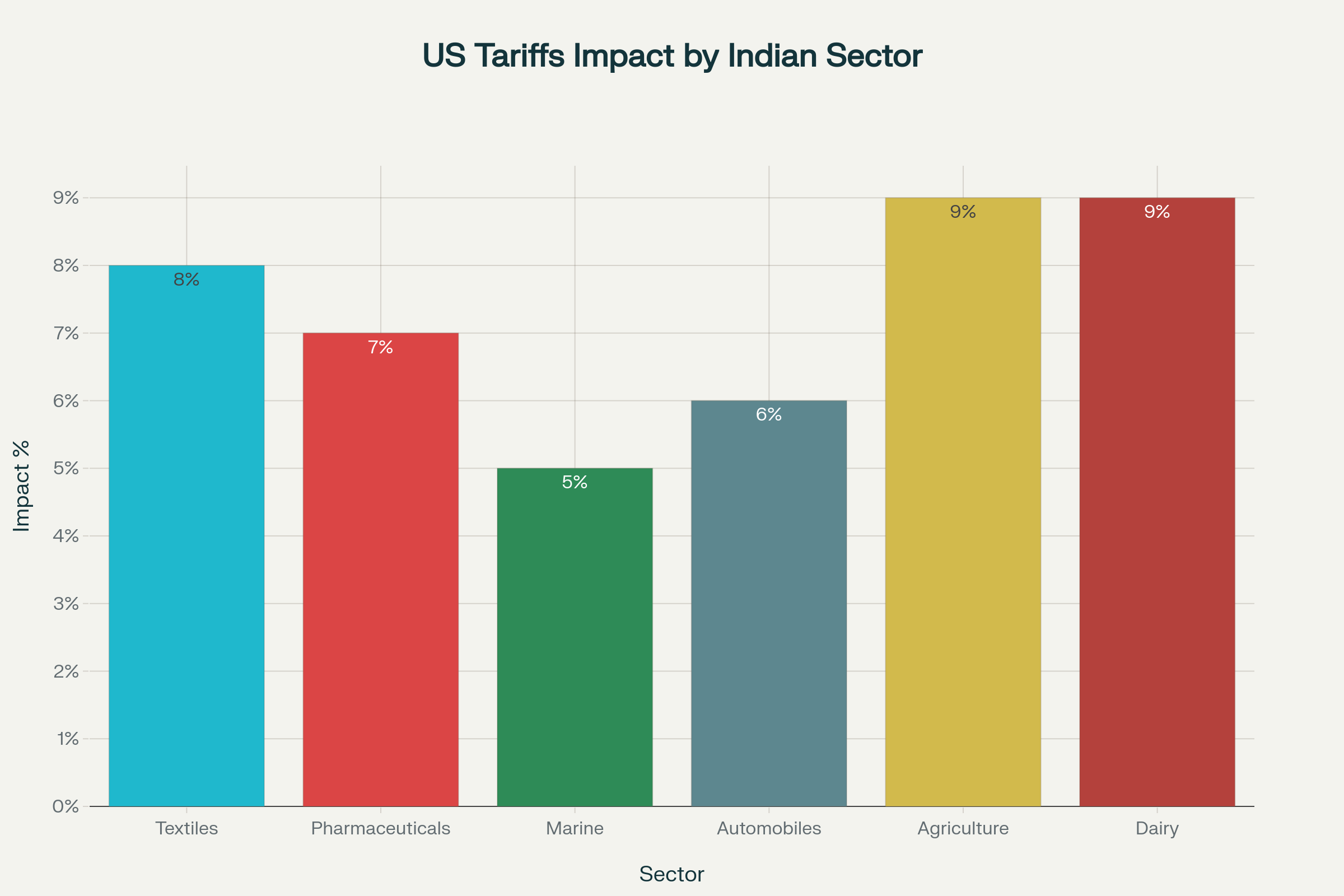
- Post by : Ibleboom
- Date :
US Slaps 25% Tariff on Indian Goods: Data Analysis, Sectoral Impact, and Geopolitical Impact..
On August 1, 2025, the United States officially imposed a 25% tariff on imports from India, with President Donald Trump—supported by Secretary of State Marco Rubio—citing India’s continued purchases of Russian oil and military equipment as the chief motivation. This move, coupled with an unspecified “additional penalty,” marks a dramatic escalation in the trade standoff and US efforts to pressure India over both trade policy and its economic ties with Russia.
Key Economic Indicators: India-US Trade Relation Snapshot
| Indicator | Value |
|---|---|
| US-India Trade Deficit (2024, USD Billion) | 45.741 |
| US Tariff Rate on Indian Goods (%) | 25 |
| Projected Impact on India’s GDP (%) | -0.2 to -0.556 |
| India’s Share of Russian Oil in Total Imports (%) | 43.278 |
Table Notes: The US-India trade deficit continued to widen in 2024. Tariffs of this magnitude are projected to shave 0.2% to 0.5% off India’s GDP, according to leading economists. Russia accounted for over 43% of Indian oil imports as of mid-2025.
Tariff and Penalty: What Led to This Standoff?
- Stalled Trade Talks: After months of negotiations, the US and India failed to reach a comprehensive trade pact. The US has accused India of maintaining high tariffs and significant non-tariff barriers, demanding greater American market access.
- Russia Factor: India’s import of Russian oil surged to record levels, reaching over 2 million barrels per day (roughly 43% of India’s total imports by June 2025). The US views these purchases as indirectly funding Russia’s war efforts in Ukraine, compounding their frustration with India’s defense procurements from Russia.
- Geopolitical Pressure: Trump’s administration frames the tariffs as both a trade and geopolitical lever, attempting to align India more closely with Western strategic aims by threatening economic pain.
Sectoral Impact: Which Indian Industries Are Most Vulnerable?
The sectors with the most at stake are export-heavy industries that rely on US market access. The following chart and table illustrate the estimated relative impact of US tariffs on major Indian export sectors:

Relative Impact of US Tariffs on Indian Export Sectors (Estimated)
| Sector | Relative Impact on Export Volume (%) |
|---|---|
| Textiles | 8 |
| Pharmaceuticals | 7 |
| Marine | 5 |
| Automobiles | 6 |
| Agriculture | 9 |
| Dairy | 9 |
- Agriculture & Dairy: These sectors face the highest relative impact, given longstanding US protectionism and the sensitivity of these goods in domestic politics.
- Textiles & Pharmaceuticals: Traditionally large Indian exporters to the US, these sectors may see diminished competitiveness versus Vietnam or China, both of which have recently struck more favorable terms with Washington.
- Marine, Automobiles: Significant, but slightly lower, impact compared to top sectors.
India’s Response and Defensive Posture
India has clearly stated it will not negotiate “under pressure,” pledging to protect national interests and safeguard sensitive sectors, especially agriculture and dairy. New Delhi has begun reassessing its oil import strategies, with state-run refiners pausing Russian crude purchases in response to narrowing discounts and US rhetoric. Privately-owned refiners and some energy brokers, however, remain active buyers, further complicating the sanctions landscape.
Chart: Estimated Sectoral Impact of US Tariffs on Indian Exports
Conclusion: Early Fallout and Road Ahead
The immediate impact includes:
- Economic: India’s GDP growth forecasts have been revised down as much as 0.5 percentage points. About 10% of Indian export value is immediately at risk.
- Political: The tariffs have united Indian policymakers in opposition, with calls to diversify export destinations and energy imports away from the US and Russia alike.
- Geopolitical: These actions inject new uncertainty into the global order, with the US’s assertive trade stance simultaneously pressuring China, Vietnam, the EU, and now India, making global supply chains more volatile and complex.
India and the US are set to resume negotiations in late August 2025, but with increased tensions and entrenched positions, any rapid breakthrough seems unlikely. The longer these tariffs persist, the greater the risk of lasting structural damage to India’s export economy and broader global trade linkages.
Some referral taken from news channels etc.
- https://www.bbc.com/news/articles/c0j91p8w20vo
- https://www.india-briefing.com/news/trump-sets-25-tariff-on-indian-exports-to-the-us-38980.html/
- https://indianexpress.com/article/india/our-friend-trump-announces-25-percent-tariff-on-india-10159543/
- https://www.visionias.in/blog/current-affairs/trumps-25-tariff-on-india-understanding-india-us-trade-diplomacy
- https://indianexpress.com/article/explained/explained-economics/road-to-october-pact-gets-tougher-shrinks-room-to-drive-a-better-deal-10160145/
- https://www.cnbctv18.com/economy/us-president-donald-trump-25-pc-tariff-on-india-economy-gdp-impact-ws-l-19646213.htm
- https://indianexpress.com/article/business/us-tariffs-india-russia-penalty-10161209/
- https://www.reuters.com/business/energy/indian-state-refiners-pause-russian-oil-purchases-sources-say-2025-07-31/
- https://www.nytimes.com/2025/07/31/business/india-russia-oil-trump.html
- https://www.reuters.com/world/india/india-vows-protect-farmers-trumps-25-tariff-threat-sparks-opposition-fury-2025-07-31/
- https://www.themoscowtimes.com/2025/07/31/indian-state-refineries-halt-russian-oil-imports-after-trump-tariff-threats-a90050
- https://economictimes.com/news/economy/foreign-trade/whos-most-at-risk-from-trumps-25-india-tariffs/articleshow/123008586.cms
- https://www.bloomberg.com/news/newsletters/2025-07-31/us-india-trade-deal-trump-brings-russian-twist-to-tariff-fight-with-modi
- https://www.lowyinstitute.org/the-interpreter/trump-s-25-india-tariffs-could-backfire-strengthen-china-india-ties
- https://www.youtube.com/watch?v=GmxLz-jZsvk
- https://www.nytimes.com/2025/07/31/world/asia/modi-trump-india-tariffs.html
- https://www.ndtv.com/world-news/live-updates-trump-announces-25-tariff-on-india-along-with-penalty-india-us-trade-trump-tariffs-donald-trump-8984303
- https://www.reuters.com/world/india/trump-says-us-india-still-negotiating-after-25-us-tariff-threat-2025-07-30/
- https://timesofindia.indiatimes.com/business/india-business/donald-trump-tariffs-news-live-updates-india-us-trade-deal-us-tariff-impact-august-1-deadline-russia-penalty-brics/liveblog/123011772.cms
- https://www.moneycontrol.com/news/business/trump-tariffs-live-updates-india-us-trade-deal-august-1-deadline-latest-news-updates-liveblog-13354790.html